Mint Ventures: A detailed explanation of the decentralized reserve stablecoin
Original author: Lawrence Lee, Mint Ventures
impossible triangle
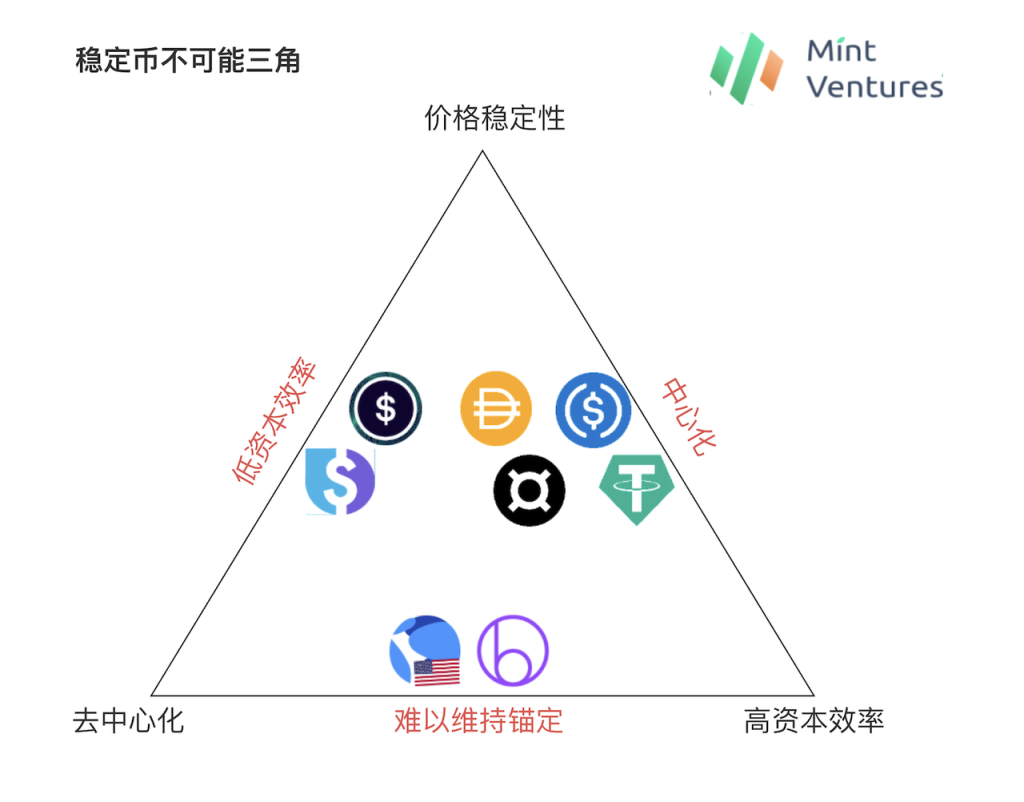
Chart: Mint Ventures
There has always been an impossible triangle in the field of encrypted stablecoins, that is, price stability, decentralization and capital efficiency cannot be achieved at the same time.
Centralized stablecoins such as USDT and USDC have the best price stability on the chain and capital efficiency as high as 100%. The only problem is the risk brought by centralization. BUSD stopped new business due to regulatory influence. In March this year The impact of the March SVB incident on USDC clearly reveals this.
The algorithmic stablecoin craze that began in the second half of 2020 attempted to realize under-collateralization on a decentralized basis. During this period, projects such as Empty Set Dollar and Basis Cash quickly collapsed; since then, Luna has used the credit of the entire public chain as a The implicit guarantee does not require over-collateralization in the process of users minting UST. It has achieved the integration of decentralization, capital efficiency and price stability for a long time (2020-May 2022), but in the end it is credit The collapse led to a death spiral; since then, projects such as Beanstalk have appeared in under-collateralized tokens, but they have not attracted much attention from the market. The difficulty in stably anchoring such tokens is the Achilles heel of their development.
The other path starts with MakerDAO, which hopes to achieve price stability at the expense of certain capital efficiency through over-collateralization of the underlying decentralized assets. Currently, Liquitys LUSD is the largest stablecoin fully supported by decentralized assets. However, in order to ensure the stability of LUSD prices, Liquitys capital efficiency is indeed low. The mortgage rate of the entire system is above 250% all year round, which means that every One circulating LUSD requires ETH worth more than 2.5 U as collateral. Synthetixs sUSD is even more extreme. Due to the greater volatility of the collateral SNX, the minimum collateral ratio required by Synthetix is often over 500%. Low capital efficiency means a low scale ceiling, which also means low appeal to users. Liquity’s planned V2 version mainly wants to solve the problem of V1’s low capital efficiency. Synthetix is also in its planned V3 version. It is planned to introduce other assets as collateral to reduce the minimum mortgage rate requirements.
DAI in the early days (2020 and before) actually also had the problem of low capital efficiency, and because the market value of the entire crypto market was small at that time, DAIs collateral ETH fluctuated greatly, and the price of DAI also fluctuated greatly. To solve this problem, MakerDAO has introduced PSM (Price Stability Module, which allows the use of centralized stablecoins such as USDC to generate DAI) since 2020. DAI is partly a trade-off between decentralization, capital efficiency and price stability. Abandoning decentralization has brought DAI a more stable price anchor and higher capital efficiency, thus better assisting DAI to grow rapidly with the overall development of DeFi. FRAX, which was launched at the end of 2020, also uses centralized stablecoins as its main collateral. Currently, DAI and FRAX are the top two decentralized stablecoins in circulation. This certainly proves that their strategies are appropriate and provides users with stablecoins that better meet their needs, but it also illustrates the need to maintain decentralization. Constraints on the scale of stablecoins.
But there are still a series of stablecoins that try to achieve high capital efficiency and strong price stability while maintaining decentralization. They all try to provide users with such a stable currency:
Generated from decentralized assets (such as ETH) to avoid censorship risks;
Using 1 USD of assets, you can generate 1 USD of stable currency without over-collateralization, which is more conducive to scale;
Stablecoin values remain stable.
In fact, this is also the theoretically best decentralized stablecoin that is most intuitive. We use Liquity V2’s naming of this type of protocol - decentralized reserve protocol to name this type of stablecoin. It should be pointed out that, unlike traditional over-collateralized stablecoins, for users, after their assets are converted into such stablecoins, the assets used to generate stablecoins are owned by the protocol and are no longer associated with the user. In other words, the user is more like performing an ETH -> stablecoin swap operation. This type of stablecoin is more similar to centralized stablecoins such as USDT. Using 1 US dollar of assets can exchange for 1 US dollar of stable currency, and vice versa. It’s just that the assets accepted by the decentralized reserve protocol are encrypted assets.
(Some people may think that the collateral is not owned by the user, so such a stablecoin does not have the leverage function, which will lose a major use case of the stablecoin. However, the author believes that the stablecoins in our real life do not have the leverage function Functions, centralized stablecoins such as USDT and USDC have never had the function of increasing leverage, settlement tools, units of account and value storage methods areCore Functions of Money, adding leverage is only a special function of CDP (Collateralized Debt Position) type stablecoins, not a general use case of stablecoins)
However, the reason why past stablecoin protocols have not been able to continue to provide such stablecoins is because the above-mentioned stablecoins have a problem that is simple to say but difficult to solve: the price of decentralized assets fluctuates greatly, how can it be 100% stable? Guaranteed payment of the stablecoins they issue under the mortgage rate?
Judging from the balance sheet of the stablecoin protocol, the collateral deposited by users is an asset, while the stablecoins issued by the protocol are liabilities. How can we ensure that the assets will always be greater than or equal to the liabilities?
Or a more intuitive example is,When ETH = 2000 U, a user sends 1 ETH to the protocol to mint 2000 stable coins. Then when ETH drops to 1000 U, how can the protocol ensure that these 2000 stable coins can still be exchanged for assets worth 2000 U?
Judging from the development history of decentralized reserve protocols, there are two main ideas to solve this problem: using governance tokens as reserves and reserve asset risk hedging. According to the method of risk hedging of reserve assets, it is divided into decentralized reserve protocols for protocol hedging risks and decentralized reserve protocols for user hedging risks. Next we will understand one by one.
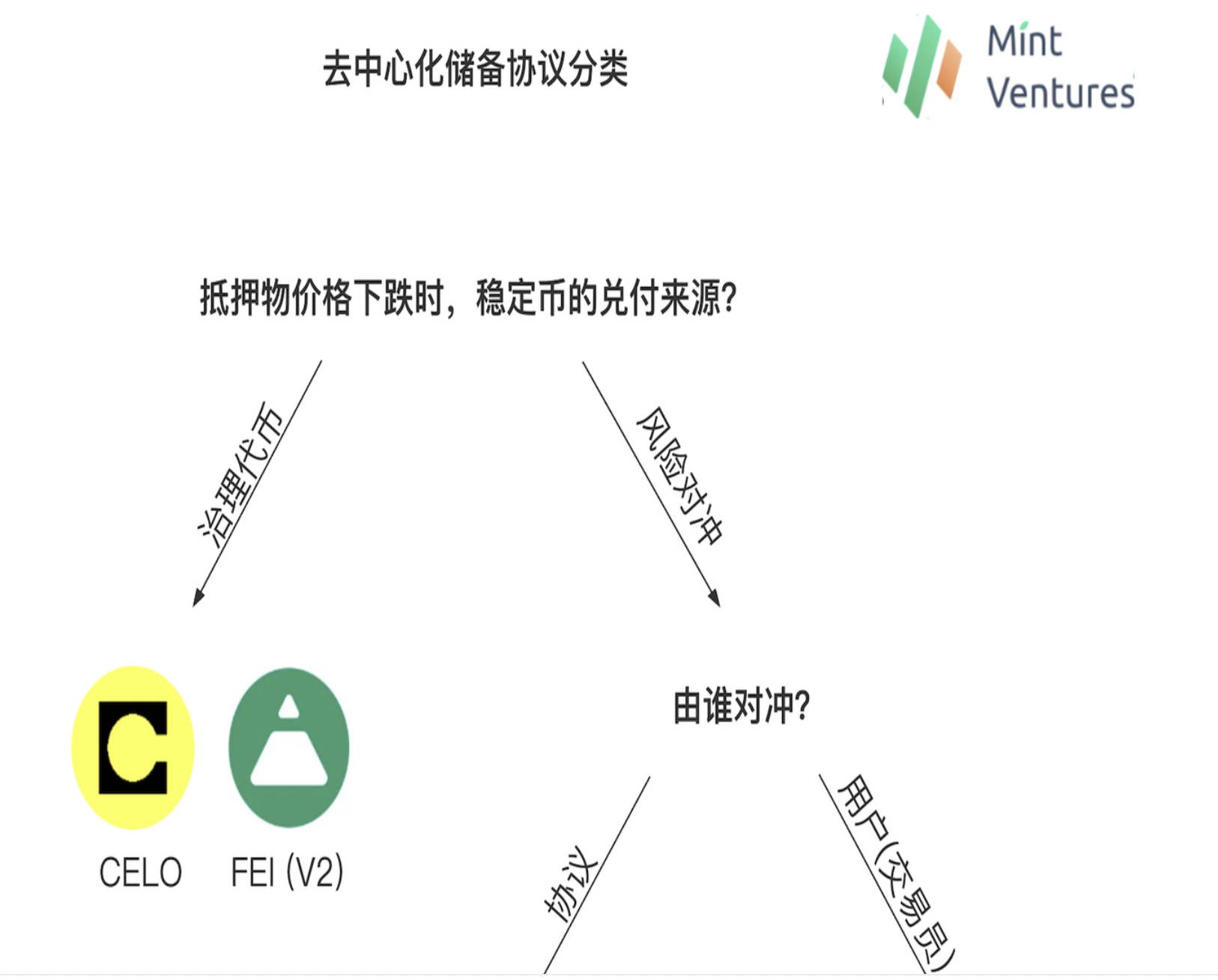
Chart: Mint Ventures
Decentralized reserve protocol with governance tokens as reserve
The idea of the first type of agreement is to use the governance token of the agreement itself as the new collateral of the agreement. When the price of collateral assets drops sharply, the agreement will mint more governance tokens to redeem stablecoin holdings People’s stablecoins can be called decentralized reserve protocols with governance tokens as reserves. In the above example, when ETH drops from 2000 U to 1000 U, the decentralized reserve protocol with governance tokens as reserves uses ETH worth 1000 U + protocol governance tokens worth 1000 U to redeem 2000 stablecoins in the hands of users .
Protocols that adopt this approach include Celo and Fei Protocol.
Celo
Celo is a stablecoin project launched in 20 years ago. They previously existed as an independent L1. In July this year, the core team proposed to transition Celo to the Ethereum ecosystem through the OP stack. Celo’s stablecoin mechanism is as follows:
Celos stablecoin is backed by a reserve pool composed of a set of comprehensive assets. The reserve rate of the reserve pool (the ratio of the value of reserve assets divided by the value of circulating stablecoins) is much higher than 1, which provides the core for the intrinsic value of its stablecoin. the underpinning
Celos stable currency is not minted by over-collateralization, but is obtained by sending Celo tokens to the official stable module Mento. Users send Celo worth $1 to get stable coins such as cUSD for $1, or they can reverse to Mento Send $1 worth of cUSD in exchange for $1 in Celo. Under this mechanism, when the market price of cUSD is lower than 1 dollar, someone will buy cUSD at a low price in exchange for 1 dollar of Celo. Similarly, when the price of cUSD is higher than 1 dollar, someone will use Celo to mint cUSD to sell, arbitrage The existence of investors will ensure that cUSD will not deviate too far from its anchor price.
There are three mechanisms that will be used to ensure sufficient funds in the reserve pool: 1. When the reserve rate is lower than the threshold, the Celo produced by the block will be included in the reserve pool to replenish capital; 2. A certain ratio of transfer rates can be charged to replenish the capital. Capital (not currently enabled); 3. Charge a certain stability fee in Mentos trading module to replenish reserve capital.
In order to improve the security of the reserve, its asset portfolio is more diverse, currently including Celo, BTC, ETH, Dai and the carbon credit token cMCO 2, which will be safer than just using project tokens as collateral (Terra is similar to this A solution, Luna is the invisible margin of its native stablecoin)
source:Mint Ventures Celo Research Report
It can be seen that Celo is similar to Luna. It is an L1 centered on stable coins. It is also very close to Luna/UST in terms of minting and redemption mechanisms. The main difference is that when the entire system enters a potential under-collateralization state At that time, Celo will first use the $CELO produced by the block as the collateral of the agreement to ensure the payment of its stable currency cUSD.
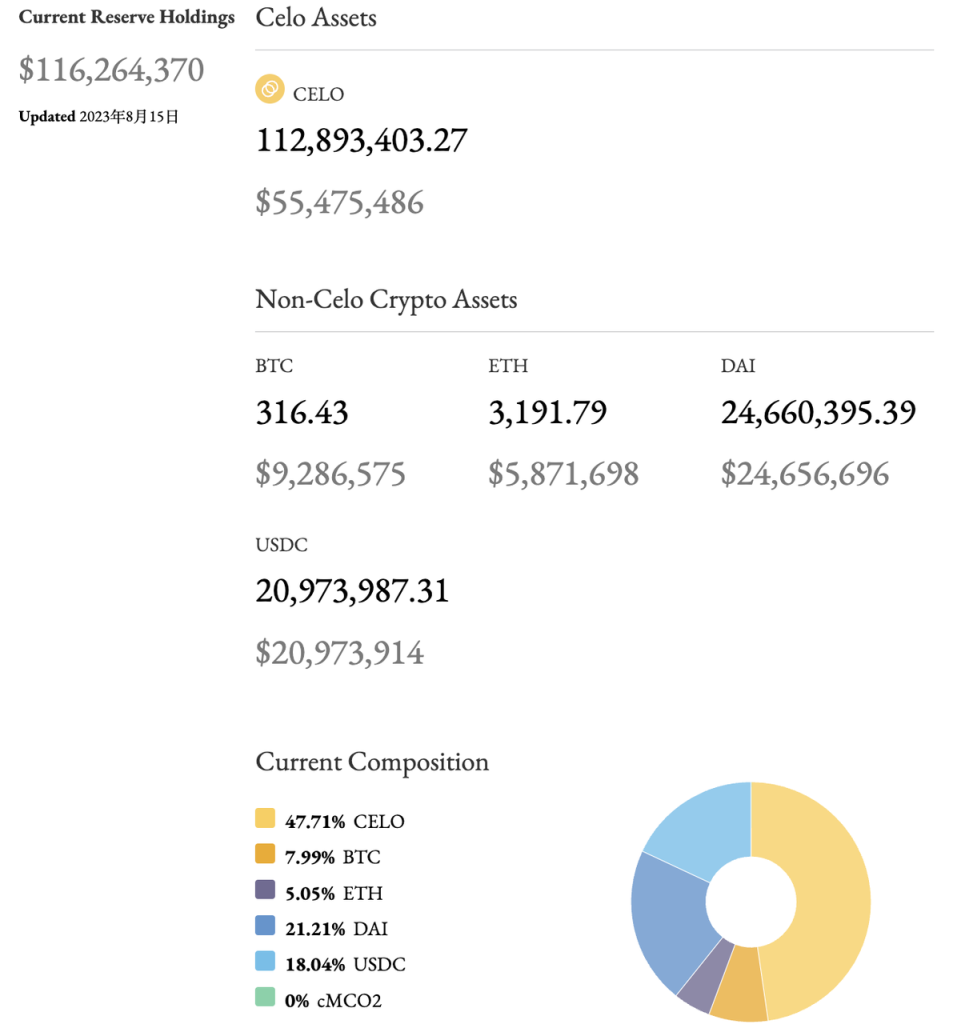

Source: https://reserve.mento.org/
At present, the Celo system has a total collateral of 116 million US dollars, a total of 46 million US dollars of stable coins issued, and an overall over-collateralization rate of 254%. Although the entire system is in an over-collateralized state, for users who want to use their stable currency cUSD , they can exchange CELO worth 1 U for 1 cUSD at any time, with excellent fund utilization. Of course, from the perspective of collateral composition, half of Celo’s collateral comes from centralized USDC and semi-centralized DAI, and Celo cannot be considered a completely decentralized stable currency.
Currently, Celos stablecoin scale ranks 16th among decentralized stablecoins (if you exclude UST and flexUSD, which cannot be pegged, it ranks 14th).
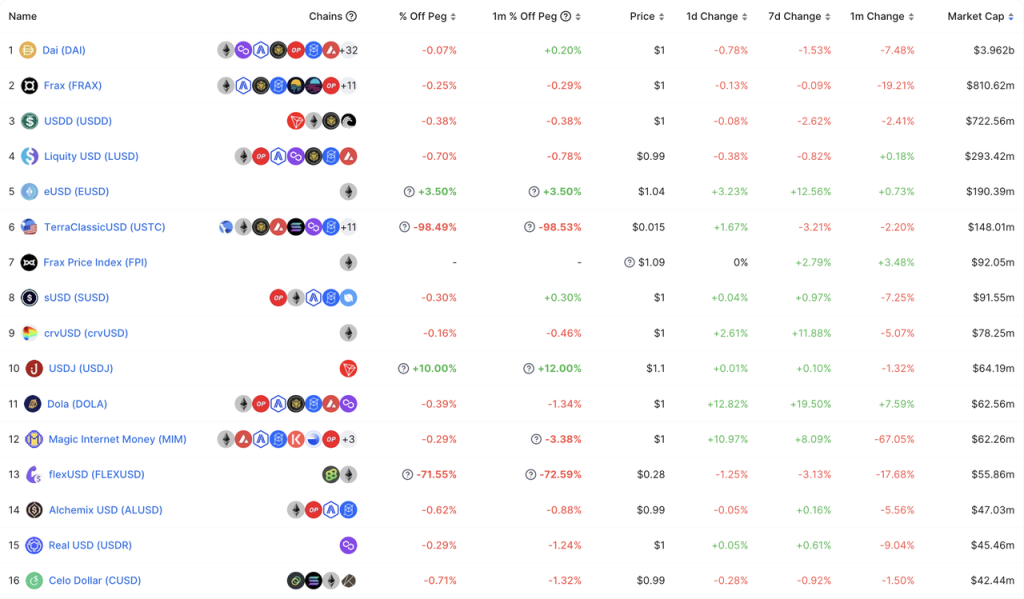
source:https://defillama.com/stablecoins?backing=CRYPTOSTABLES&backing=ALGOSTABLES
Fei
At the beginning of 2021, Fei Protocol, which received US$19 million in financing from institutions such as A16Z and Coinbase, attracted widespread attention in the market because it also had the hottest algorithmic stablecoin concept in the market at the time. In the initial stage of their project issuance (at the end of March), 639,000 ETH were attracted to participate in the minting of the stablecoin FEI, generating a total of 1.3 billion FEI, which also made FEI a decentralized stablecoin second only to DAI. currency (the circulating market value of DAI at that time was US$3 billion).
Subsequent demand for FEI was oversatisfied in the creation stage in a short period of time (users mainly want to obtain the governance token TRIBE of Fei Protocol), and the supply of FEI was severely oversupplied, while the newly launched stable currency FEI has no application scenarios. So FEI has been below $1 for a long time. Soon after that, the market volatility in May ushered in. The panic of falling prices caused users to redeem FEI one after another, making the protocol sluggish since it was launched.
Since then, in the V2 version that will be launched at the end of 2021, Fei Protocol has proposed a series of measures to try to bring the development of the protocol back on track, including modifying its price stabilization mechanism. In V2, FEI can be directly generated from ETH, DAI, LUSD and other collaterals at a 100% mortgage rate. After the stablecoin is generated, the users collateral is included in the Protocol Controlled Value (PCV, Protocol Controlled Value). When the mortgage rate of the agreement (= PCV / circulating FEI) is higher than 100%, it means that the asset appreciation of the agreement is in good condition, and there is no pressure on the redemption of FEI. The agreement will issue a part of FEI to purchase TRIBE, thereby reducing the mortgage rate of the agreement; Similarly, when the mortgage rate of the agreement is lower than 100%, there is a possibility that the agreement cannot fully redeem all FEI, and the agreement will also issue a part of TRIBE to purchase FEI, thereby increasing the mortgage rate of the agreement.
Under this mechanism, the governance token TRIBE becomes a backup cash for FEIs entire system in case of potential risks, and can also obtain additional income when the system grows (this mechanism is similar to the Float Protocol launched together with Fei V1). Unfortunately, the launch of Fei V2 coincided with the high point of the entire bull market. Since then, the price of ETH has been falling all the way. Unfortunately, Fei suffered a hacker attack in April 22 and lost 80 million FEI, and finally decided to terminate it in August 2022. Protocol development.
The decentralized reserve protocol that uses governance tokens as reserves essentially dilutes the rights and interests of all governance token holders to ensure the redemption of stablecoins. In the bull market cycle of the market, along with the increase in the scale of stable coins, governance tokens also rise, and it is easy to form an upward flywheel. However, in the bear market cycle of the market, as the reserve assets on the protocol asset side decline, the total market value of the governance token itself will also decline with the market. At this time, if more governance tokens need to be issued, the governance token will be There could be further declines, forming a death spiral for governance token prices. However, if the market value of governance tokens falls below a certain percentage of stablecoins, the entire agreement’s commitment to stablecoins will no longer be credible in the eyes of stablecoin holders, which will eventually accelerate the escape and lead to a death spiral for the entire system . Whether it can survive the bear market is the key to the survival of this type of stable currency. In fact, the reason why Celo can survive in the current bear market is inseparable from the overall over-collateralized status of the protocol. The reason why the protocol is over-collateralized The status is also because when the market was high before, Celo allocated a relatively large amount of reserves to USDC/DAI and BTC/ETH, so that the protocol can still maintain the security of the protocol when the price of CELO drops from 10 to 0.5.
Decentralized Reserve Protocol for Reserve Asset Risk Hedging (Risk-Neutral Stablecoin Protocol)
The idea of the second type of agreement is to carry out some risk hedging of these encrypted assets on the asset side of the agreement. When the price of the collateral asset falls sharply, the hedging realizes the income so as to ensure that the assets of the stablecoin agreement can always repay the debt. We call this type of agreement a decentralized reserve agreement for reserve asset risk hedging, or a risk-neutral stablecoin agreement. In the above example, after receiving 1 ETH worth 2000 U, the decentralized reserve protocol for reserve asset risk hedging will hedge the risk of this 1 ETH (such as opening a short order on the exchange), when ETH changes from 2000 U U falls to 1000 U, and the decentralized reserve protocol for reserve asset risk hedging uses 1000 U worth of ETH + 1000 U worth of hedging proceeds to redeem 2000 stablecoins in the hands of users.
Specifically, depending on the specific hedger, it is divided into a decentralized reserve agreement for protocol hedging risks, and a decentralized reserve agreement for users to hedge risks.
Decentralized reserve protocol for hedging risks
Stablecoin protocols that adopt this approach include Pika Protocol V1, UXD Protocol, and Ethena, which recently announced financing.
Pika V1
Pika Protocol is currently a derivatives protocol deployed on the Optimism network, but in its initialV1 versionAmong them, Pika once planned to launch a stable currency, and its hedging was achieved through Bitmexs inverse perpetual contract (Inverse Perpetual).Inverse Perpetual Contract(or coin-based perpetual contract) is also one of the inventions of Bitmex. Compared with the more popular linear perpetual contract to track the price of the currency with the U standard, the reverse perpetual contract is characterized by the currency standard to track prices in U. Examples of income from inverse perpetual contracts are as follows:
A trader goes long 50, 000 contracts of XBTUSD at a price of 10, 000. A few days later the price of the contract increases to 11, 000.
A trader is long 50,000 XBTUSD contracts at a price of 10,000. A few days later, the contract price rose to 11,000.
The trader’s profit will be: 50, 000 * 1 * ( 1/10, 000 - 1/11, 000) = 0.4545 XBT
The traders profit will be: 50,000 * 1 * (1/10,000 - 1/11,000) = 0.4545 XBT
If the price had in fact dropped to 9, 000, the trader ’ s loss would have been : 50, 000 * 1 * ( 1/10, 000 - 1/9, 000) = -0.5556 XBT. The loss is greater because of the in verse and non-l in ear nature of the contract. Conversely, if the trader was short then the trader’s pr of it would be greater if the price moved down than the loss if it moved up.
If the price actually fell to 9,000, the traders loss would be: 50,000 * 1 * ( 1/10,000 - 1/9,000) = -0.5556 XBT Due to the inverse and non-linear nature of the contract, The loss is greater. Conversely, if a trader is short, then if the price falls, the traders profit will be greater than the loss if the price rises.
Source: https://www.bitmex.com/app/inversePerpetualsGuide
After a little analysis, it is not difficult to find that the reverse perpetual contract and the decentralized reserve agreement for risk hedging of reserve assets are a match made in heaven. It is still our above example. Suppose that when ETH = 2000 U, Pika Protocol receives the users 1 After 1 ETH, I shorted 2000 ETH reverse perpetual contracts on Bitmex using 1 ETH as a margin. When the price of ETH drops to 1000 U, the profit of Pika Protocol = 2000 * 1 * (1/1000-1/2000 ) = 1 ETH = 1000 U. That is to say, when the price of ETH drops from 2000 U to 1000 U, the reserve of Pika Protocol protocol at this time changes from 1 ETH to 2 ETH, which can still effectively redeem the 2000 stable coins in the hands of users (the above does not consider transaction fees and funding rate costs). Product design of Pika Protocol V1 with the founder of BitmexArthur Hayes in his blog postThe product design of NUSD mentioned in is exactly the same, and it can always perfectly hedge the long position of currency standard.
Unfortunately, for the vast majority of USDT-based crypto investors, inverse perpetual contracts have inverse and non-linear characteristics of returns (the relationship between the rise and fall of the local currency and the rise and fall of the contract is not linear) , is not very easy to be understood by ordinary users. In the subsequent development process, the development of reverse perpetual contracts (coin-based perpetual contracts) is far less than the currently popular linear perpetual contracts (U-standard perpetual contracts). ), on mainstream exchanges, the trading volume of inverse perpetual contracts is only about 20-25% of that of linear perpetual contracts. BitMex, which has been affected by regulation, has gradually degenerated from a first-tier contract exchange to a current contract market share of less than 0.5%. Pika believes that linear perpetual contracts cannot meet their hedging needs, while the market space for inverse perpetual contracts is relatively small. And in itV2 versionShe gave up the stable currency business and officially turned to the derivatives exchange.
UXD
UXD Protocol is a stablecoin protocol running on the Solana network and will be launched in January 2022. UXD once completed a $3 million financing led by Multicoin in 2021, and raised $57 million in IDO. In January of this year, UXD decided to cross-chain and enter the Ethereum ecosystem. Arbiturm was launched in April, and Optimism is planned to be launched later.
When it was first launched, UXD Protocol supported users to deposit SOL, BTC and ETH to mint its stablecoin UXD according to the USD value 1:1. The collateral deposited by users will be opened short through Mango Markets, Solanas lending and perpetual contract exchange. Hedging is done on a single basis, and the payment of the stable currency is realized through hedging. The capital fees charged by the short order will be used as income from the agreement, while the capital fees paid will be advanced by the funds raised by the agreement. For a long time after it went online, the UXD protocol worked well. The protocol even needed to limit the issuance limit of UXD. This is because the overall open position of Mango Markets is below 100 million US dollars. If the short position of UXD reaches tens of millions of US dollars, , you face the risk of potential failure to deliver; in addition, too many short positions will also make the funding rate more likely to become negative, thereby increasing hedging costs.
Unfortunately, Mango Markets suffered a governance attack in October 2022, and UXD suffered a loss of nearly $20 million in this incident. At that time, UXDs insurance fund balance still had more than $55 million, so UXD could receive normal payments. Although Mango Markets later returned the funds of the UXD protocol, Mango Markets has been in trouble since then. It also coincided with the FTX thunder incident that caused funds to quickly flow out of Solana, and UXD was unable to find a suitable exchange to hedge their long positions. Since then, the only collateral supported by the UXD protocol is USDC, and USDC does not need to hedge risks, so they have invested the users collateral USDC in various on-chain USDC vaults and RWA. It was also after this that UXD decided to cross-chain and enter the Ethereum ecosystem. It has launched Arbirturm in April and plans to launch Optimism later. They are also continuing to look for suitable on-chain hedging places.
Currently, the circulation of UXD is 14.3 million USD, and the balance of the agreement insurance fund is 53.2 million USD.
Source: https://dashboard.uxd.fi/
In addition, the stablecoin protocol Ethena Finance, which recently announced financing, will also use risk hedging to hedge its reserve assets. Ethena Finance received $6 million in financing led by Dragonfly, with participation from centralized exchanges such as Bybit, OKX, Deribit, Gemeni, and Huobi. Ethenas financing institutions include many second-tier derivatives exchanges, which will be helpful for hedging its collateral. In addition to this, Ethena also plans to cooperate with decentralized derivatives protocolsSynthetix collaboration, opening short positions on Synthetix as a liquidity provider and bringing more use cases to its stablecoin USDe (allowing USDe to be used as collateral for certain pools).
For decentralized reserve protocols that hedge risks, the advantages are obvious. By hedging the crypto assets of the collateral, the protocol can obtain a risk-neutral position as a whole, thus ensuring the payment of stable coins and ultimately achieving decentralization. 100% capital efficiency on the basis of hedging (mainly depends on the hedging venue). At the same time, if the agreement can complete position hedging in a highly capital-efficient manner, the collateral reserves owned by the agreement can also earn interest in many forms. In addition, there are funding rates that can be used as income for the agreement, thus giving the agreement more benefits. Flash transfer space: These benefits can be distributed to stablecoin holders to create interest-bearing stablecoins and give stablecoins more use cases; they can also be distributed to governance token holders.
In fact, the governance token of any stablecoin protocol has the implicit use case of serving as the lender of last resort for its stablecoin. A stablecoin protocol that reserves asset risk hedging can also use its governance token as its stablecoin under extreme circumstances. The source of currency redemption. For stablecoin holders, holding this stablecoin provides an additional layer of protection than simply using governance tokens as a reserve stablecoin. And from a mechanism perspective, the logic of reserve asset risk hedging is more self-consistent. In theory, it will not be affected by market cycles, and there is no need to test the resilience of the governance token itself in a bear market.
However, there are also many limitations to development:
Centralization risk in hedging venues. At present, centralized exchanges still occupy the vast majority of the liquidity of perpetual contracts, and the design of most decentralized derivatives exchanges is not suitable for stablecoin protocols to hedge, so it is inevitable that the agreement will face the central ation risks. The centralization risk here may be divided into two categories: 1. The inherent risk of the centralized exchange itself; 2. Because the total number of hedging places is small, a single hedging place will inevitably occupy a large proportion of the agreement’s hedging positions. If there is a problem in a certain hedging place, it will also have a great impact on the agreement. UXD Protocol suffered losses due to the attack on Mango Markets and caused the agreement to stop functioning. This is an extreme example of this centralization risk.
There are certain restrictions on the choice of hedging instruments. The current mainstream linear perpetual contract method cannot perfectly hedge their long positions. We still take ETH as an example. The stablecoin protocol requires ETH as collateral and ETH-based short order hedging. At present, the linear perpetual contract with the largest trading volume needs USD T as collateral, and its short-selling yield curve is also based on the USD standard, which cannot be perfectly hedged with the ETH of the position. Even if the stable currency agreement uses ETH to obtain USD T through some kind of loan, this will increase the operating cost and the difficulty of position risk management, and will also reduce capital efficiency. From the above example of Pika Protocol, we know that the reverse perpetual contract is the perfect choice for the decentralized reserve protocol trying to hedge the risk of reserve assets, but unfortunately the market share of the reverse perpetual contract is not large enough.
Scale growth is somewhat self-limiting. The growth of the protocol’s stablecoin scale means that there needs to be long-lasting and sufficient perpetual contract short positions for hedging. In addition to the complexity of obtaining enough short positions, the more short positions held by the protocol itself, the liquidation The higher the liquidity requirements for counterparties, the more likely the funding rate will be negative, which means potentially higher hedging costs and operational difficulty. For a stablecoin worth tens of millions of dollars, this may not be a big problem. If you want to go further and reach a scale of hundreds of millions or even billions, this problem will obviously restrict its ceiling.
Operational risk. No matter which form of hedging is used, it will involve relatively high-frequency operations of position opening, position adjustment, and collateral management. These processes inevitably require manual intervention, which will generate considerable operational risks and even moral hazards.
Decentralized reserve protocol for users to hedge risks
Protocols that adopt this approach include Angle Protocol V1 and Liquidity V2.
Angle V1
Angle Protocol was launched on the Ethereum network in November 2021. They had previously received US$5 million in financing led by a 16 z.
Regarding the protocol design of Angle Protocol V1, readers can go to Mint Ventures Previousresearch reportTo learn more, we briefly describe it below:
Like other decentralized reserve protocols, Angle ideally supports users to use 1 U of ETH to generate one of its stablecoins agUSD (of course the first stablecoin launched by Angle is agEUR anchored to the euro, but the logic are the same, for the convenience of unifying the context, we still use US dollar stablecoins as an example). The difference is that in addition to traditional stablecoin demanders, Angle’s users also include perpetual contract traders, which Angle calls HA (Hedging Agency, hedging agency).
Still the example we mentioned above, when ETH = 2000 U, a user sends 1 ETH to Angle to mint 2,000 USD stablecoins, at this time, Angle will open a leveraged position worth 1 ETH for trading We assume that HA uses 0.2 ETH (worth 400 U ) as collateral to open a 5-fold leveraged position. At this time, the collateral of the agreement is 1.2 ETH (worth 2 400 U ) in total, and the liability side totals 2000 U stablecoin.
When ETH rises to 2200 U, the protocol only needs to keep ETH that can be redeemed to 2000 U stablecoin, that is, 0.909 ETH, and the remaining 0.291 ETH (worth 640 U) can be withdrawn by HA.
When ETH drops to 1800 U, the protocol still needs to retain ETH that can be redeemed to 2000 U of stablecoins, that is, 1.111 ETH. At this time, HAs margin position will become 0.089 (worth 160 U).
It can be seen that traders are essentially long ETH on the currency standard. When the price of ETH rises, in addition to the increase in ETH itself, they can also obtain part of the surplus ETH of the protocol (in the above example, the price of ETH rises 10%, traders gain 60%); and when the price of ETH drops, in addition to the drop in ETH itself, they also need to bear the drop in the protocol collateral, ETH (in the above example, the price of ETH drops by 10%, the trader loses 60%). From Angle Protocols perspective, traders hedge the risk of falling collateral prices for the protocol, which is where its name, Hedging Agent, comes from. Traders’ long leverage depends on the ratio between the protocol’s open hedging positions (0.2 ETH in the example above) and the protocol’s stablecoin position (1 ETH in the example above).
For perpetual contract traders, using Angle to conduct long transactions on perpetual contracts has certain advantages: 1. They do not need to pay funding fees (centralized exchanges usually pay funding fees from long positions to short positions); 2. The transaction price is directly According to the oracle price, there is no slippage. Angle hopes to achieve a win-win situation for stablecoin holders and perpetual contract traders: stablecoin holders can obtain high capital efficiency and decentralization; contract traders can also obtain a better trading experience. Of course, this is only an ideal situation. In practice, there will be no traders to open long orders. Angle has introduced a standard liquidity provider (Standard Liquidity Provider, SLP) to provide additional collateral (stable currency) for the protocol to continue to guarantee The security of the protocol while automatically earning interest, transaction fees, and governance token $ANGLE rewards.
The actual operation of Angle is not ideal. Although traders also have a lot of $ANGLE as rewards, most of the time, the collateral of the agreement has not been fully hedged. The core reason is that Angle does not provide A product that is attractive enough for traders. As the price of the $ANGLE token fell, the protocol TVL also dropped from $250 million at launch to about $50 million.
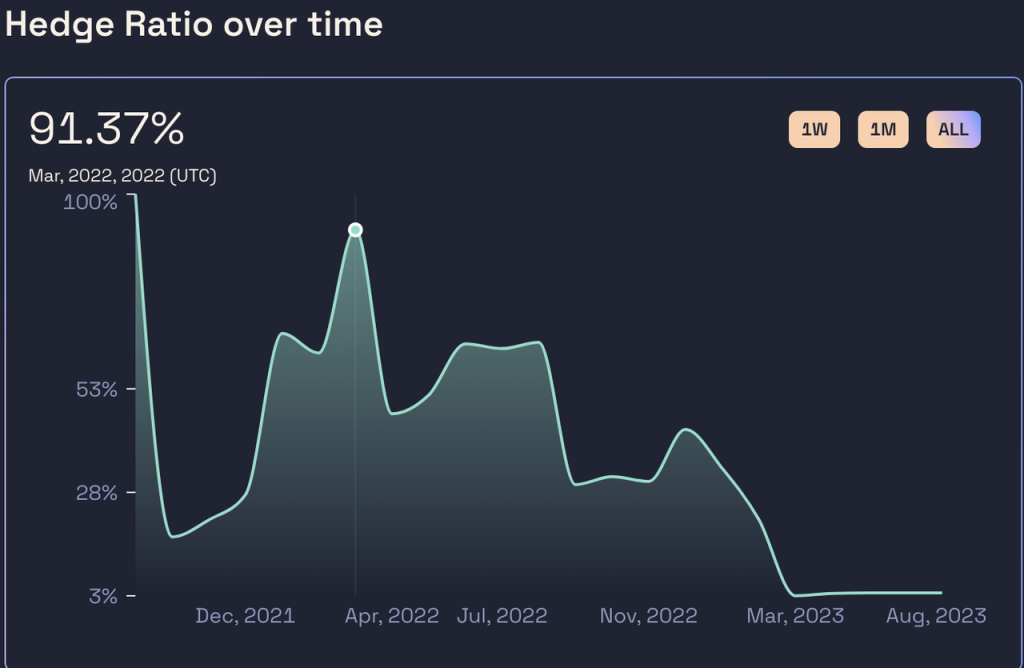
The main source of collateral for Angle stablecoins - the hedging rate of the USDC pool
Source: https://analytics.angle.money/core/EUR/USDC
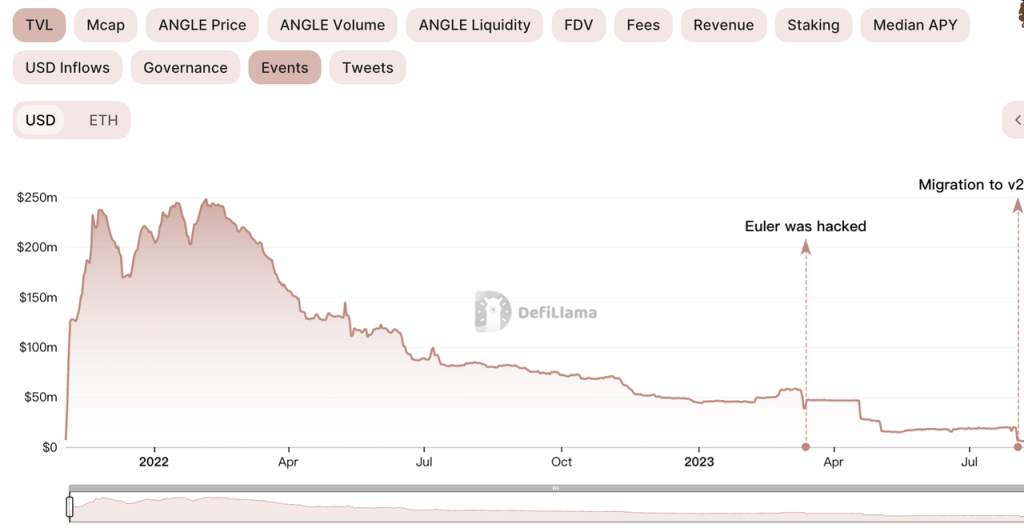
Source: https://defillama.com/protocol/angle
In March 2023, Angles reserve assets used to earn interest were unfortunately attacked by Eulers hacker. Although the hacker eventually returned the corresponding assets, Angles vitality was severely damaged since then. In May, Angle announced the end of the above logic The product they called Angle Protocol V1 and launched the V2 plan. Angle Protocol V2 changed to the traditional over-collateralization model and was just launched in early August.
Liquity V2
Since its launch in March 2021, LUSD issued by Liquity has become the third largest decentralized stablecoin in the entire market (after DAI and FRAX), and the largest fully decentralized stablecoin.July 2021andApril 2023Research reports have been published separately to discuss the mechanism of Liquity V1 and subsequent product updates and use case expansion. Interested readers can go to learn more.
The Liquity team believes that LUSD has achieved a relatively good level in terms of decentralization and price stability. But in terms of capital efficiency, Liquiditys performance is relatively average. Since its launch, Liquiditys system mortgage rate has been around 250%, which means that each circulating LUSD requires 2.5 U worth of ETH for collateral.
Source: https://dune.com/liquidy/liquidy
Liquity officially introduced the features of its V2 on July 28. In addition to supporting LSD as collateral, the core content mainly claims that it achieves high capital efficiency through risk hedging (delta-neutral hedging) of the entire protocol.
Currently, Liquidity has not disclosed specific product documents. The current public information about V2 mainly comes from founder Robert Laukos speech at ETHCC, previous introductory articles published by Liquidity, and discussions in Discord. We will organize the following mainly based on the above information.
In terms of product logic, Liquity V2 is similar to Angle V1. It hopes to introduce traders to carry out leveraged transactions on Liquity, use the margin of these traders as the supplementary collateral of the agreement, and use traders to hedge the risks of the entire agreement. At the same time, for traders, Liquity provides them with attractive trading products.
Specifically, Liquity proposes two innovations. The first is the so-called principal-protected leverage trading. Liquity will provide contract traders with a leverage trading product that protects principal. After the user pays a certain premium (premium), You can use this function, which allows them to recover a certain amount of U even if ETH drops significantly. According to the example in the Liquity article, when the ETH price is 1000 U and the user pays 1 2 ETH (of which the principal is 10 ETH and the premium is 2 ETH), he can obtain a 2 times leverage long position of 10 ETH + downside protection. That is to say, when The ETH price doubles, and the 2x leverage long position takes effect. The increase allows the user to obtain a total of 40 ETH; when the ETH price falls, the put option purchased by the user takes effect, and the user can withdraw his or her 10,000 U (10* 1,000) at any time.
Source: https://www.liquity.org/blog/introducing-liquity-v2
It can be seen that the innovation of Liquitys products based on Angle is mainly the principal protection function. Although Liquidity did not explain how it is implemented, based on the product form and discussions in Discord, this principal protection function is very much like a call option.
Liquity believes that this combination product will be more attractive to traders because it can protect principal. Call options allow traders to obtain leveraged income when prices rise, and guarantee principal when prices fall. From a traders perspective, they may indeed be more attractive than Angles pure leverage trading products (of course, the specifics also depend on the Liquity’s pricing of the royalty). From the perspective of the protocol, the royalties paid by users can become the safety cushion of the protocol: when the price of ETH falls, Liquity can use this part of the royalties as supplementary collateral to redeem stablecoin holders; when the price rises, The increased value of Liquidity’s own collateral can also be distributed to contract traders as profits.
Of course, there are obvious problems in this mechanism, that is, when traders want to close their positions midway and get back their own ETH, Liquity will fall into a dilemma: traders certainly have the right to close their positions at any time, but if they Once the position is closed, the proportion of the entire Liquity protocol position being hedged will be reduced, and the security of the Liquity protocol will become vulnerable as this part of the collateral is withdrawn. In fact, the same problem has arisen in the actual operation of Angle. The hedging rate of Angles system has remained at a low level all year round, and traders have not fully hedged the overall position of the protocol.
In order to solve this problem, Liquity proposed the second innovation, the officially subsidized secondary market.
In other words, in addition to being able to open and close positions like normal leveraged trading positions, leveraged trading positions (NFTs) within Liquidity V2 can also be sold in the secondary market. In fact, for Liquidity, they are worried about traders closing their positions because this will bring about a reduction in the protocols hedging ratio. When a trader wants to close a position, if other traders are willing to buy from the secondary market at a price higher than the intrinsic value of the current position, they will naturally be happy to receive more cash, and for Liquidity Although this current position intrinsic value is subsidized by the protocol, the hedging rate of the entire system can be maintained through a relatively small proportion of subsidies, thereby improving the security of the protocol at a relatively small cost.
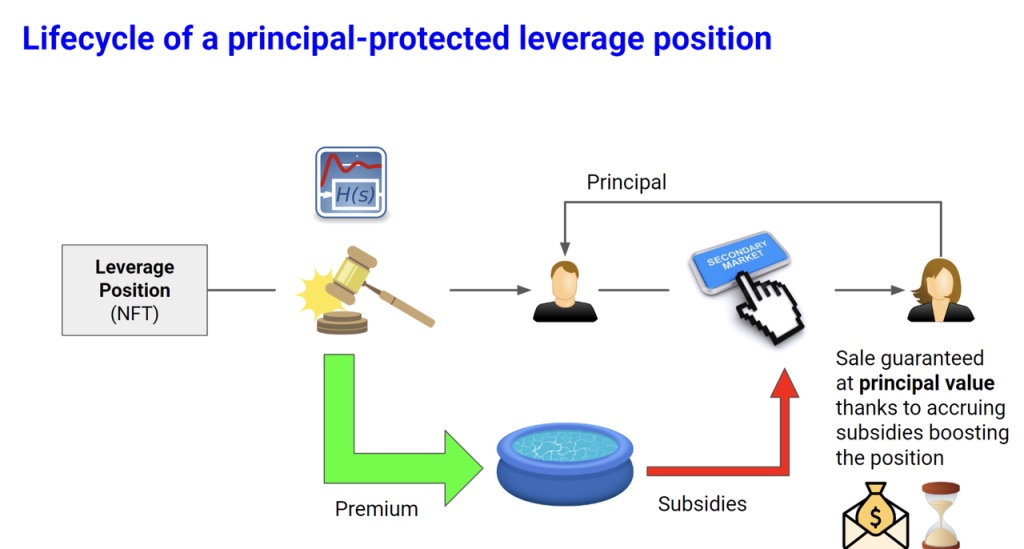
Source: https://www.liquity.org/blog/introducing-liquity-v2
For example, if Alice opens a 10 ETH position when the ETH price is 10 00 U, the premium is 2 ETH. This position corresponds to the long position of 10 ETH + the value of principal protection. But at this time, ETH fell to 800 U, and the value of the 12,000 U ETH invested by Alice can currently only be exchanged for 10 ETH (8,000 U). At this time, in addition to directly closing this position and obtaining 10 ETH (8,000 U), Alice also He can also sell his position on the secondary market at a price between 8000 U - 12000 U. For Bob who wants to buy Alices position, the act of buying Alices position is a bit similar to buying when ETH is 800 U (8000 U + a call option with an exercise price of 10 00 U). This option must be It is valuable, so this also determines that the price of Alices position must be higher than 8000 U. For Liquidity, as long as Bob purchases Alices position, the mortgage rate of the protocol will not change, because the premium collected by the protocol is still in the protocol fund pool. If Bob does not come to buy Alices position for a long time, the Liquidity protocol will slowly increase the value of Alices position over time (the specific form is not specified, but such as lowering the exercise price and increasing the number of call options can increase the value of Alices position). The value of this position), the part of the subsidy comes from the protocols premium pool (note that this situation will slightly reduce Liquitys overall overcollateralization rate). Liquity believes that not all positions need to be subsidized by the agreement, and the subsidy does not necessarily need to subsidize a large proportion of the position income, so subsidizing the secondary market can effectively maintain the hedging ratio of the agreement.
Finally, through these two innovations, there may still be no way to completely solve the lack of liquidity in extreme situations. Liquidity will also use a standard liquidity provider mechanism similar to Angle as a final supplement (the possible way is that the protocol will also allow users to deposit A part of V1 LUSD enters the stable pool to support the redemption of V2 LUSD in extreme circumstances).
Liquity V2 is planned to be launched in Q2 of 24.
Overall, Liquity V2 has many similarities with Angle V1, but it also makes targeted improvements to solve the problems encountered by Angle: it proposes the innovation of principal protection and provides traders with more attractive products; and proposes an “officially subsidized secondary market” to protect the overall hedging ratio of the protocol.
However, Liquidity V2 is still essentially the same as Angle Protocol. It is the stablecoin teams attempt to cross-border a derivative product with certain innovation and feed back its stablecoin business. The Liquity teams ability in the stablecoin field has been proven, but it is doubtful whether it can also design excellent derivatives, find PMF (Product Market Fit, products match market demand) and promote them smoothly.
Conclusion
A decentralized reserve protocol that can achieve decentralization, high capital efficiency and maintain price stability at the same time is exciting, but an exquisite and reasonable mechanism design is only the first step in a stablecoin protocol, but what is more important is the stablecoin. Use case expansion. The current decentralized stablecoins are generally making slow progress in use case expansion. Most decentralized stablecoins have only one real use case of mining tools, and the incentives for mining are not inexhaustible.
To a certain extent, Paypal’s issuance of PYUSD is a wake-up call for all crypto stablecoin projects, because it means that well-known institutions in the web2 field have begun to enter the field of stablecoins, and the time window left for stablecoins may not be It wont be long. In fact, when we talk about the centralization risk of managed stablecoins, we are more worried about the risks brought about by unreliable custodians and issuers (Silicon Valley Bank is only the sixteenth largest bank in the United States, Tether and Circle is just an encryption-native financial institution), if there is a too big to fail financial institution (such as JP Morgan) in the traditional financial field to issue stable coins, the national credit behind it is not only It will make Tether and Circle lose their foothold in an instant, and it will also greatly weaken the value of decentralization advocated by decentralized stablecoins: when centralized services are stable and powerful enough, people may not need decentralization at all .
Until then, we hope that decentralized stablecoins can gain enough use cases to reach the Schelling point of stablecoins, although this is difficult.



